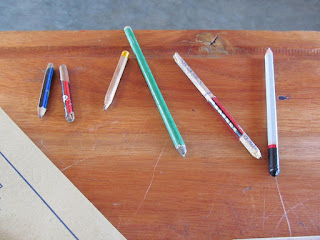Inspired by my family’s entrepreneurship, and in need of
more materials for the library, I have taken up the cause of raising R2000 to
help my school acquire approximately 750 more books. It is more or less the
same as trying to raise $2000 because all the fundraisers are designed to earn
a rand or two per item, just like an American school fundraiser would only be
earning a dollar or two per item.
The most important things I have started in this effort are the School Store
and School Photos. At the School Store, we sell blue pens, red pens, and
pencils, and hopefully we will soon sell rulers and pencil sharpeners – I just
need to shop around to find the best prices. Each of the three current items
can be purchased for R2 or R1 when the store is open before school begins.
Since I buy the cheapest pens and pencils in the world, and I buy them in bulk,
the school earns R1 per sale for pens and about R0.60 for pencils. Right now,
we are on track to raise approximately R50 a week, which doesn’t sound like a
lot but is actually pretty good business.
 |
| The School Store. That's right, it's the top of my desk. |
The School Photos were inspired by my days as the Yearbook
Adviser (days I am quite happy are in the past, by the way.) Each week this
term I haven taken the photos of all the learners in one of the grades, so I
have everyone’s picture on file. It may not be quite as efficient as Picture
Day back home, but it’s working so far. It should come as no surprise that
there aren’t school photos at my rural, village school. There are only a few
people in the village that even own a camera, and to get pictures printed, you
need to go to the bigger town about 75km (and two taxi rides) away, which costs
approximately R100 roundtrip. So, even though it may cost only R3 to print a
picture, there are several other key costs involved that prohibit people from
having pictures of anything except the biggest of occasions (such as weddings
or 21st birthday parties). This year, however, each family will have
a chance to purchase a school photo! And unlike the school photo packages in
America, which require you to take out a loan to get one 5x7 and a few wallets,
we are selling them for rock bottom prices. For the equivalent of approximately
$.60, anyone can buy a 4x6, and the school still earns R2. There are two larger
sizes as well for approximately $1.25 and $1.50, which actually bring in quite
a profit since the guy that works at the drug store only charges me for a 4x6
even when I print bigger pictures. He knows it’s a fundraiser ;-) I don’t want
to pretend like the orders are pouring in, because they are not. The fact
remains that extra money is not something most people have. But there have been
a few early buyers, and after delivering the first batch of photos, more
learners and parents are starting to order. And it is fun to see the kids’ eyes
light up when they receive a big, color photo of themselves. As someone who
loves pictures, I think its really nice that some of the kids and families will
have one more picture for their photo albums.
 |
| School Photos! Not something you see very often in rural South Africa. |
Once we have our R2000, we will pool it with funds from 29
other schools from across South Africa that are part of a project to bring a
container of books from America through the non-profit organization, Books for
Africa. This is not a new or unique idea – PCVs all over Africa use this
organization. But I’m excited nonetheless to possibly double the number of
books we currently have in our school library. If you are interested in
learning more about or helping the cause, you can read all about our project
and even donate through
the Books for Africa website.
Otherwise, I’m going to hope the School Store continues to
provide learners with the supplies they need as well as the opportunity to save
for something that they want. I’m also hoping that the photos are something
that both learners and parents will enjoy. They may or may not realize it, but
their small purchases are helping themselves and future students gain access to
better resources for years to come.






